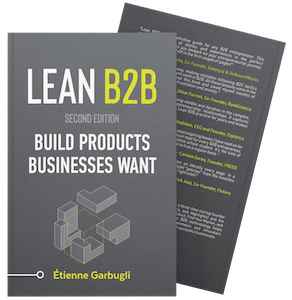“It’s not that the customer may not have the problem, it’s just, they may not want the solution you’re selling.” – Dan Martell, Serial Entrepreneur
Although you can use landing pages to presell smaller dollar-value products, it’s highly recommended to do preselling face-to-face, or over the phone in B2B. Doing so will help you capture objections and get more direct feedback.
Create a brochure, a one-pager, or a short presentation. Focus on the Job, the needs and desired outcomes, the problems, the core value, and how your product will be differentiated. Don’t go too deep into the product features and specifications. The important thing is to establish compelling value, and to ask for the sale. Creating a brochure, for example, will keep you from becoming too inwardly focused.
Don’t worry too much about how much you charge. At this stage, it’s more about money changing hands than generating a certain amount of revenue.
With preselling, only unaffiliated revenue counts. Go see your ideal customers, explain how your product concept addresses their needs, and try to get 10 prospects to buy before you have a finished product.
If they buy, make sure you take the money. Prospects will often start asking different questions once they are committed.
Common Objections
If they don’t buy, make sure you understand why:
- Was the price too high? The perception of value was either too low to warrant the change or the risk is viewed as too high.
- Were the budgets already assigned? Is this a stalling technique? What’s the real issue? Can budgets be reassigned?
- Is it not a priority? Why isn’t it a priority? What is getting prioritized over this?
- Is there too much risk? How can you mold your solution to make it easier to adopt? Can you take on some of their responsibilities?
- Will someone object? What are their concerns?
- Is something missing? What features are missing? What outcomes are neglected? Why do those features matter?
- Was the value not clear enough? Was it the pitch or the value proposition? Take a step back. Refine your value proposition based on the new findings.
- Did the proposition not sell enough value? What were the expectations? What would be deemed as ‘enough’?
- Was it not the right time? Why is it not the right time? Are they lacking resources? Are there ways to reduce the perception of risk?
- Are there other solutions in the pipeline? What solutions are getting prioritized? Are they external or internal solutions? Is your product sufficiently differentiated?
- Are they committed with the competition? How could you create more valued differentiation?
Learning Through Preselling
Take note of the objections and keep pitching. Only consider changing your concept once you’ve pitched more than 20 qualified prospects without being able to get a sale.
As serial entrepreneur Dan Martell says: “Most people make the mistake of changing the specs on the product for every conversation. As a result, they end up with different feature requests, and all of a sudden, they have ten new customers and ten new features to add, and it’s essentially professional services.”
Don’t move forward until you’re able to get 5-10 pre-orders for your product concept.
More on Preselling
- How to Find an Internal Change Agent to Make the Sale in B2B
- Why Startup Founders Shouldn’t Outsource Sales in Early Stage Startups
- How to Map the Needs of the Decision-Making Unit (DMU) in B2B Sales
Download the First 4 Chapters Free
Learn the major differences between B2B and B2C customer development, how to think about business ideas, and how to assess a venture’s risk in this 70-page sampler.
Working on a B2B Startup?
Learn B2B customer development with our free email course:


